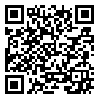Volume 19, Issue 1 (Vol.19, No.1, Spring 2023)
irje 2023, 19(1): 60-72 |
Back to browse issues page
Download citation:
BibTeX | RIS | EndNote | Medlars | ProCite | Reference Manager | RefWorks
Send citation to:



BibTeX | RIS | EndNote | Medlars | ProCite | Reference Manager | RefWorks
Send citation to:
Didarloo A, Fathi B, Hosseini R, Pirnejad H, Ghorbanzadeh S, Yasamani K. Determinants of COVID-19 Vaccination Intention Among the General Population of Urmia City: an Application of Health Belief Model. irje 2023; 19 (1) :60-72
URL: http://irje.tums.ac.ir/article-1-7223-en.html
URL: http://irje.tums.ac.ir/article-1-7223-en.html
Alireza Didarloo * 
 1, Behrouz Fathi2
1, Behrouz Fathi2 
 , Raana Hosseini3
, Raana Hosseini3 
 , Habibollah Pirnejad4
, Habibollah Pirnejad4 
 , Sima Ghorbanzadeh5
, Sima Ghorbanzadeh5 
 , Kajal Yasamani5
, Kajal Yasamani5 


 1, Behrouz Fathi2
1, Behrouz Fathi2 
 , Raana Hosseini3
, Raana Hosseini3 
 , Habibollah Pirnejad4
, Habibollah Pirnejad4 
 , Sima Ghorbanzadeh5
, Sima Ghorbanzadeh5 
 , Kajal Yasamani5
, Kajal Yasamani5 

1- Professor, Department of Public Health, School of Public Health, Social Determinants of Health Research Center, Clinical Research Institute, Urmia University of Medical Sciences, Urmia, Iran , didarloo_a@umsu.ac.ir
2- Assistant Professor, Department of Health Economics and Management, School of Public Health, Urmia University of Medical Sciences, Urmia, Iran
3- Assistant Professor, Department of Social Medicine, Faculty of Medicine, Social Determinants of Health Research Center, Clinical Research Institute, Urmia University of Medical Sciences, Urmia, Iran
4- Associate Professor, Department of Health Information Technology, Faculty of Paramedicine, Social Determinants of Health Research Center, Clinical Research Institute, Urmia University of Medical Sciences, Urmia, Iran
5- Masters Student in Health Education & Promotion, Department of Public Health, School of Public Health, Urmia University of Medical Sciences, Urmia, Iran
2- Assistant Professor, Department of Health Economics and Management, School of Public Health, Urmia University of Medical Sciences, Urmia, Iran
3- Assistant Professor, Department of Social Medicine, Faculty of Medicine, Social Determinants of Health Research Center, Clinical Research Institute, Urmia University of Medical Sciences, Urmia, Iran
4- Associate Professor, Department of Health Information Technology, Faculty of Paramedicine, Social Determinants of Health Research Center, Clinical Research Institute, Urmia University of Medical Sciences, Urmia, Iran
5- Masters Student in Health Education & Promotion, Department of Public Health, School of Public Health, Urmia University of Medical Sciences, Urmia, Iran
Abstract: (655 Views)
Background and Objectives: Vaccination stands as a paramount achievement in global public health and a key strategy to control COVID-19. Vaccine acceptance is a pivotal determinant of the success or failure of vaccination programs. Leveraging health education models and theories to predict behavioral intention, this study aimed to investigate the determinants of the intention to receive the COVID-19 vaccine among the general population of Urmia using the Health Belief Model (HBM).
Methods: This descriptive-analytical study employed a cross-sectional approach among 575 individuals aged over 18 residing in Urmia. Sampling was conducted through the snowball and convenience sampling methods. Data was collected using a valid and reliable electronic researcher-made questionnaire comprising four sections: demographic characteristics, knowledge, HBM constructs, and intention to receive the COVID-19 vaccine. Data were analyzed using descriptive and inferential statistics in SPSS version 16.
Results: The HBM effectively explained 67% of the variance in the intention to vaccinate against COVID-19. Within the model's constructs, individuals' perceived self-efficacy (β = 0.505, P = 0.001) emerged as the strongest predictor of the intention to receive the COVID-19 vaccination. Other influencing factors included perceived susceptibility (β = 0.158, P = 0.001) and perceived barriers (β = -0.109, P = 0.001).
Conclusion: Given the robust predictive ability of the HBM for the intention to vaccinate against COVID-19, this model can be utilized in educational and behavioral programs and interventions. Special emphasis should be placed on effective constructs, particularly self-efficacy, to enhance citizens' willingness to receive the COVID-19 vaccine.
Methods: This descriptive-analytical study employed a cross-sectional approach among 575 individuals aged over 18 residing in Urmia. Sampling was conducted through the snowball and convenience sampling methods. Data was collected using a valid and reliable electronic researcher-made questionnaire comprising four sections: demographic characteristics, knowledge, HBM constructs, and intention to receive the COVID-19 vaccine. Data were analyzed using descriptive and inferential statistics in SPSS version 16.
Results: The HBM effectively explained 67% of the variance in the intention to vaccinate against COVID-19. Within the model's constructs, individuals' perceived self-efficacy (β = 0.505, P = 0.001) emerged as the strongest predictor of the intention to receive the COVID-19 vaccination. Other influencing factors included perceived susceptibility (β = 0.158, P = 0.001) and perceived barriers (β = -0.109, P = 0.001).
Conclusion: Given the robust predictive ability of the HBM for the intention to vaccinate against COVID-19, this model can be utilized in educational and behavioral programs and interventions. Special emphasis should be placed on effective constructs, particularly self-efficacy, to enhance citizens' willingness to receive the COVID-19 vaccine.
Type of Study: Research |
Subject:
Special
Received: 2023/03/17 | Accepted: 2023/09/25 | Published: 2023/06/10
Received: 2023/03/17 | Accepted: 2023/09/25 | Published: 2023/06/10
Send email to the article author
| Rights and permissions | |
 |
This work is licensed under a Creative Commons Attribution-NonCommercial 4.0 International License. |



